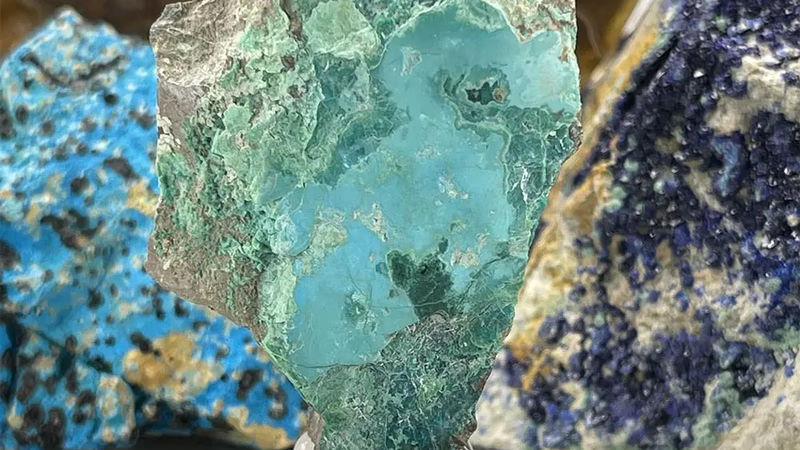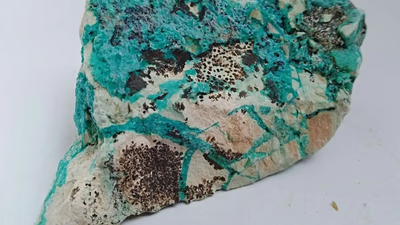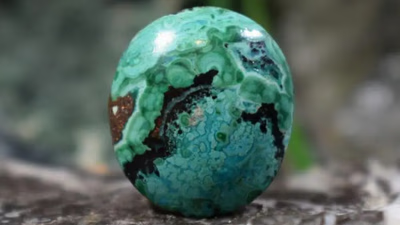
Chrysocolla stone showcasing its unique color patterns.
During a visual inspection, several characteristics can help identify chrysocolla. The color of chrysocolla typically falls within the blue to green spectrum, with shades ranging from light sky blue to deep turquoise. However, it's important to note that other minerals can exhibit similar colors. Additionally, chrysocolla often displays characteristic patterns, including a mottled or uneven color distribution. It may also be mixed with other copper minerals such as malachite, azurite, or turquoise. Lastly, evaluating the luster of the stone is essential. Chrysocolla usually exhibits a vitreous (glassy) to dull luster.
Physical property testing involves assessing specific properties of chrysocolla. One crucial property is hardness, which is measured on the Mohs scale. Chrysocolla has a hardness of 2.5 to 3.5, which means it can be scratched by a copper coin (hardness of 3) but not by a fingernail (hardness of 2.5). It's important to exercise caution during this test to prevent any damage to the stone. Another property to consider is specific gravity, which for chrysocolla ranges from approximately 2.0 to 2.4. Specific gravity tests can be conducted using specialized equipment. Lastly, the streak test involves rubbing the mineral on an unglazed porcelain tile to observe the color of its powdered form. In the case of chrysocolla, the streak is typically white to light blue-green.
Chrysocolla can be difficult to detect by its chemical composition because it does not have a definite and uniform chemical composition. Its chemical formula can vary depending on different impurities. Basically, any silicate containing copper in a spherical shape, blue to green, cannot be a rock except chrysocolla. Chrysocolla can often be identified by its hardness, unique color, and interesting patterns. However, depending on the exact composition, the hardness can also vary, but in most cases, chrysocolla stones can be detected by scratch testing. Due to its visual similarities in color and luster, Chrysocolla is often confused with turquoise and azurite.
Chrysocolla is slightly softer than turquoise. Smithsonian is similar in appearance, but its color is slightly lighter and harder. Varicose veins are very similar, but they are usually much greener in color and usually much harder than Chrysocolla. The most important mines of Chrysocolla are Israel, Congo (Zaire), Chile, United Kingdom, Cluj, Katanga (Shaba), Mexico,Peru, Russia and the United States (Arizona, Utah, Idaho, New Mexico, Michigan and Pennsylvania). Arizona is now recognized as the best producer of Chrysocolla. The Timna copper mine was famous in ancient Israel for producing mixed Chrysocolla. Western Australia is also known for producing chrysocolla azurite quasi-minerals. Other notable chrysocolla locations in the world include; Mexico, Peru, Chile, Democratic Republic of Congo (Zaire), Australia, Russia, Cornwall in England, France, and Israel..
Advanced analytical techniques can provide further insight into the identification of chrysocolla. Spectroscopic analysis helps identify the specific wavelengths of light absorbed by the mineral, aiding in confirming its identity. X-ray diffraction (XRD) is another technique used to examine the crystal structure of the mineral, providing valuable information for positive identification. Infrared spectroscopy (FTIR) analyzes the specific vibrational modes of the mineral's molecules, creating a unique fingerprint for chrysocolla.
For a definitive identification, it is recommended to consult a professional gemologist. These experts possess advanced tools and expertise, enabling them to accurately identify chrysocolla and differentiate it from minerals that bear a resemblance. When purchasing chrysocolla, especially valuable pieces, there are a few tips to keep in mind. Look for certification from reputable gemological laboratories, as this ensures the authenticity and quality of the gemstone. It is also advisable to buy from trusted dealers or jewelers who can provide provenance information, verifying the source and authenticity of the chrysocolla.
-

Chrysocolla is a captivating gemstone known for its vibrant blue and green hues, classified as a hydrated copper phyllosilicate mineral. It typically forms in the oxidation zones of copper deposits, with notable sources including Arizona, New Mexico, Chile, Peru, and Israel. The gemstone exhibits a hardness of 2. 5 to 3. 5 on the Mohs scale, making it relatively soft and requiring careful handling. Its luster ranges from vitreous to dull, and it can be opaque to translucent. Chrysocolla is often used in jewelry as cabochons or beads due to its attractive colors and is also valued for its metaphysical properties, believed to enhance communication and self-expression. Additionally, it has applications in decorative objects and carvings.
Despite being lesser-known, Chrysocolla"s unique characteristics make it sought after by gem enthusiasts. The name derives from Greek words meaning "gold" and "glue
-

Inspecting rough chrysocolla is essential for determining cutting methods. The stone should be examined for cracks and weak spots before marking it for cutting. A trim saw with a diamond blade is used to cut the stone into slabs, ensuring a constant water flow to cool the blade and minimize dust. Safety precautions, including goggles and gloves, are necessary during this process. Shaping involves using a lapidary grinder with coarse grit wheels, followed by finer grits for smoothing. Polishing enhances the stone"s luster using a polishing wheel and compounds like cerium oxide. Chrysocolla can be fashioned into cabochons for jewelry, particularly pendants and earrings, due to its softness and sensitivity to water. Careful maintenance is crucial; avoid prolonged exposure to water, direct sunlight, and harsh chemicals.
When cleaning, use a soft cloth with mild soap. Store chrysocolla separately from other gemstones to prevent scratches. Artisans may apply protective coatings to enhance durability. Common shapes include ovals and free-cuts, while calibrated sizes are preferred for specific applications. "
-

Chrysocolla is identified through visual inspection and physical property testing. Its color ranges from blue to green, often displaying mottled patterns. The hardness of chrysocolla is between 2. 5 and 3. 5 on the Mohs scale, making it softer than turquoise. Specific gravity tests reveal values between 2. 0 and 2. 4, while the streak test shows a white to light blue-green powder.
Due to its variable chemical composition, chrysocolla can be confused with similar minerals like turquoise and azurite. Notable sources include Arizona, Israel, and the Democratic Republic of Congo, with advanced techniques like spectroscopic analysis and X-ray diffraction aiding in identification. For accurate results, consulting a professional gemologist is recommended, especially when purchasing valuable pieces. Buyers should seek certification from reputable laboratories and buy from trusted dealers to ensure authenticity.
-

Chrysocolla and turquoise, while both featuring vibrant blue to green hues, are distinct minerals with unique properties. Chrysocolla is a hydrated copper phyllosilicate, softer than turquoise, which is a hydrated phosphate of copper and aluminum. The hardness of chrysocolla ranges from 2. 5 to 3. 5 on the Mohs scale, whereas turquoise measures between 5 and 6. Their luster also varies; chrysocolla typically has a vitreous to dull finish, while turquoise displays a waxy to subvitreous sheen. Geologically, both stones are associated with copper deposits but differ in structure: chrysocolla often appears botryoidal or massive, while turquoise is found in nodules or veins within host rock. Specific gravity further distinguishes them—chrysocolla"s ranges from 2.
0 to 2. 4 compared to turquoise"s 2. 6 to 2. 9. Chrysocolla"s attractive light blue and turquoise green colors stem from copper impurities, making it sought after by gem enthusiasts despite being lesser-known than turquoise. The name "chrysocolla" derives from Greek words meaning "gold" and "glue
-

Chrysocolla is a unique gemstone characterized by its vibrant blue to green hues, often found in massive or botryoidal forms. Its appearance can vary significantly based on its mineral associations, such as when combined with quartz, resulting in varieties like Chrysocolla Chalcedony. Other notable combinations include Eilat Stone and Sonora Sunrise, which showcase striking color patterns. Identifying chrysocolla involves examining its color distribution, hardness (2. 5-3. 5 on the Mohs scale), specific gravity (2. 0-2. 4), and luster.
While pure chrysocolla is rare, it is often sold mixed with other minerals under the same name. Similar gemstones include turquoise, malachite, azurite, and variscite, each differing in hardness and appearance. Pricing for chrysocolla jewelry depends on factors such as weight, color purity, cutting quality, and transparency levels ranging from D (clearest) to M (most opaque). Understanding these characteristics is essential for both buyers and sellers in the gemstone market.





